 Up to the Index Page
Up to the Index PageThe gods existed partially in this world through their statues, which were washed, dressed and brought food like living beings by the priests. At certain times of the year the god paid visits to each other's temples, carried on special boats along the Nile and giving their blessings to the land.
These manifestations doesn't have to be consciously divine to be manifestations of the gods. A falcon seen as a sign from Horus or a dream revealing the wishes of Isis are completely natural phenomena, but work as coincidental explanations for the divine activities in the world. Even people may be manifestations of the gods; a great and righteous warrior manifests the virtues and power of Horus even if he doesn't know anything about Egyptian mythology and acts entirely of his own accord. Some individuals strive to manifest their gods more fully (like some Christians attempting Imitationi Christi), and by devoutness become more clear manifestations of their gods. This was the basis of much of Egyptian religious magick: by invoking the gods into themselves, the mages would temporarily manifest their powers.
In the same way there is no contradiction between seeing the gods as heroic representations of leaders and heroes of the past and true gods; the heroes reflected the god which they later became identified with, and by their physical existence they made the god known. There may once have been a great hero or mage known as Osiris that latter generations worshipped as a god. But that doesn't mean Osiris the god didn't exist before Osiris the man, who was his avatar (in the Hindu sense; compare this to the myths of the avatars of Vishnu). Osiris the man revealed the myth of Osiris the god.
It should be noted that the Egyptian gods were not simply umbrood beings playing games with the humans, the interaction was much more subtle. According to some theories, spirits and other aetheric beings need the perceptions and beliefs of people to gain shape and power (compare this to Adam naming the animals - to name something is to give it existence). Thus the worship of the gods gave them form, individuality and the ability to manifest in the world. If this worship is broken or forgotten, the gods will retire to the high umbra and loose their individuality until it is restored.
The basic dogma of the ruler-cult proclaimed that the pharaoh was the earthly manifestation of the sky god Horus. So the myth of transmission of kingship from Osiris via the machinations of Isis to her son Horus is vital to understanding the status and power of the soverign in ancient Egypt. George Hart, Egyptian MythsThe central myth of importance in this chronicle is the family feuds of Isis, Osiris, Set and Horus. A highly condensed version follows (see any book about Egyptian mythology for more details):
Osiris and Set were the sons of Nuit and Geb. As Ra retired Osiris ascended to the throne, becoming the ruling god. But Set wanted the power, and lured Osiris into a trap and killed him. He scattered his body into pieces, throwing them into the Nile and crowning himself as the new ruler. But Isis, Osiris widow, managed to gather the parts of Osiris' body with the help of her friends, and then revived it with the magick of Anubis (Set's son) and Nepthys (Set's wife and Isis sister); this was the origin of the mummification ritual. Although she could not restore Osiris to true life, he could ascend to the throne of the underworld, becoming the ruler of the dead. He also sired a son with his wife.
When Set heard about it he was enraged and sent his warriors after the fleeing Isis. After many adventures and dangers she found sanctuary in the delta, where she gave birth to Horus. The god grew up in secret, protected and instructed by his mother. Finally he was old and strong enough to confront his uncle, claiming his right to the throne. The dispute turned into a great duel of which many stories have been written, but in the end Set was defeated and humiliated, and Horus ascended to the throne, becoming the new ruler of gods and men.

The chain of command in Egypt was unbroken -- each King, though a living, breathing being, was a renewal of the covenant which the gods made with man. The dead King, though dead to this world, lived on in spirit as he made his way back to the beginning, to the First Time. His son, the new Horus King, took over his place as surely as the dead King has taken his own, and ensured the continuation of the Great House, the Pr Aa.
Homage to thee, Osiris, Lord of eternity, King of the Gods, whose names are manifold, whose forms are holy, thou being of hidden form in the temples, whose Ka is holy. Book of the DeadOsiris is the god of the underworld and the dead, but also vegetation and agriculture. He is the harvest, the bull that dies that others may live, similar to many of the other dead-but-resurrected harvest gods of the middle east. His power is vast, since he rules the netherworld where even the boat of the sun is endangered - if he allowed it even the day would be extinguished.
Osiris is depicted as a seated mummy on a throne, holding a flail and crook, crowned by the atef crown (the white crown of upper Egypt with two red feathers on the sides). He is the brother of Isis, Set and Nepthys, son of Nuit and Geb.
Symbols: crook and flail, djed, White and Atef Crowns, bull, mummified form, throne, the constellation of Orion when under the horizon.
Offerings: beef, beer, breads, black dirt, farming instruments, wheat
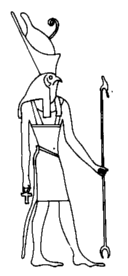
"I Ptolemy, the satrap, restore to Horus, the avenger of his father, the territory of Patanut [Egypt], from this day forth ever..." Ptolemy I Soter, the Satrap Stele
Heru reigns not in our time, but in and beyond the future. He embodies the fears and hopes for all of our tomorrows, commands the coming of each new day, and whispers the secrets of his time to the prophets of our own. Dr. Corey Bantik, Modern Egyptian Ritual MagickHorus is the warrior-god of the Kingdom, representing just and upright leadership and things to come. He is usually depicted as a falcon or a falcon- headed human. He is the son of Isis and Osiris who avenged his father and reclaimed the crown from his uncle Set.
There are many versions of the god, worshipped at different places and times:
Harpokrates (The infant Horus) Horus as a child, representing the new born sun (and in thelemic magick as the god of silence, since he is depicted as holding his index finger to his lips). Depicted as a shaved child with a sidelock, with a royal crown and uraeus.
Harendotes (Horus the avenger of his father) Horus as a grown man, who fights to reclaim the land and avenge his father.
Har-pa-Neb-Taui (Horus Lord of the Two Lands) Horus as king of the lands.
Haroeris (Horus the Elder) An early form of Horus. He was a god of light. His eyes represented the sun and the moon.
Horus Behudety (Horus of Edfu). Horus as the midday sun. Originally worshipped in the western delta and eventually his cult spread to his great shrine in Edfu. Horus of Edfu fights a great battle against Set and his minions in the form of a winged sun disk or as a hawk headed lion.
Ra-Harakhte (Horus of the two horizons) Horus identified with Ra and the daily voyage of the sun from horizon to horizon. The composite deity was represented as a falcon or a falcon-headed man wearing a solar disk and double crown.
Harmakhet (Horus in the Horizon) Horus as the rising sun, associated with Khepri. Depicted as a man with a falcon's head or a sphinx (the sphinx has been widely worshipped as a manifestation of Harmakhet).
The Eye of Horus, known as the Udjat eye, is a very powerful symbol for divine power. It is said to represent the healthy eye of Horus (the other was wounded by Set, but magickally restored by Isis) identified with the sun. Since Horus and Re sometimes were amalgamated, it is sometimes called the Eye of Re (or the left eye is the eye of Re and the right the eye of Horus).
Symbols: hawk/falcon, bull, ichneumon (mongoose), Double Crown, Winged Disk, Udjat, Sphinx, weapons, iron, blacksmiths, the constellation Orion (when over the horizon)
Offerings: red meat, pork, iron, weapons, lapis, mummified hawks

A clever woman... more intelligent than countless gods... She was ignorant of nothing in heaven and earth Chester Beatty PapyrusIsis is the wife and sister of Osiris. She is usually depicted carrying a head-dress with a throne (her name means "Stone seat") or a moon and sun disk (a later addition). She is the goddess of nature, magick and power, the great mother who protects her family and brings up the king. Of the entire Egyptian pantheon she is the goddess who still is most active today, taking an interest in the events of the world and trying to further her own aims.
Isis was well known as the most skilled magician of the gods, having tricked even Ra into revealing his true name to her. There was nothing she couldn't do, and she is depicted on the tarot as the high priestess carrying the scroll of secrets.
Offerings: wine, milk, flowers, pomegranates, myrrh, "buckle of Isis" (tyit amulet)
Symbols: throne, kite, scorpion, sistra, Sirius (see Sothis)
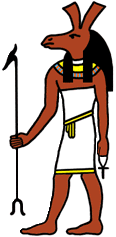
[Typhon was called Seth, and Bebo, and Smy] ...all of them words of one common import, and expressing certain violent and forcible restraint and withholding, as likewise contrariety and subversion; we are, moreoever, informed by Manetho that the lodestone is by the Egyptians called the 'bone of Horus,' as iron is, the 'bone of Typho.' Plutarch, De Iside et OsirideSet is the warrior-god of desert, eternally opposed to the god-king Horus of the Nile. He is the brother of Isis, Osiris and his wife Nepthys. He is usually depicted as having a head of a strange animal, somewhere between a donkey, a tapir and a giraffe. This animal, known as the Set beast, has never been identified but ancient texts refers to it as "rude" and violent; it may have gone extinct or now exist as bygones in the Umbra.
Set is not just the cartoon evil god some make him out to be; Set has his own reasons to be what he is. Once Set was the god of the Seti people in Lower Egypt, a red-haired people whose standard was the Set beast. The Seti were defeated by the Horu people, worshipers of Horus and the eventual creators of the first dynasty. Ever since, Set has been in opposition to Horus and the rulership he represents, sometimes overpowering his rival, sometimes defeated. His goal is to destroy all authority and spread the deserts and wastelands over the world, a revenge for all his defeats and humiliations. However, these motivations are not widely known, and most mages simply regard Set as the pure antithesis of the ordered divine warrior-king Horus: the god of foreign invasions, lack of control and disaster.
In the sky he corresponds to the constellation Scorpio and the red star Antares, on the opposite side from Orion/Horus.
Symbols: Seth-animal, pigs, donkeys, fishes
Offerings: pork and other meat, strong spicy dishes and drinks, weapons and iron, sand
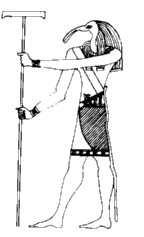
...The ancient Egyptians had... worshipped Thoth as 'the personification of the mind of god', as 'the author of every work on every branch of knowledge, both human and divine', and as 'the inventor of astronomy and astrology, the science of numbers and mathematics, geometry and land surveying, medicine and botany." Graham Hancock, The Sign and the Seal
Thoth was also regarded as a deity who understood the mysteries of 'all that is hidden under the heavenly vault', and who had the ability to bestow wisdom on selected individuals. It was said that he had inscribed his knowledge in secret books and hidden these around the earth, intending that they should be sought by future generations but found 'only by the worthy' - who were to use their discoveries for the benefit of mankind. Graham Hancock, Fingerprints of the GodsThoth is the god of wisdom, letters, the recording of time, science, magick, the scribe at the divine court. He is depicted as ibis-headed, often carrying a scribes pallet or a papyrus. He is said to be self- created before creation, the one who gave Ptah the Word that caused everything to come into being. He is also seen as a moon- god, possibly because he won the five sacred days of the year from the moon-god Khonshu in a game of draughts.
Thoth is the most important deity to the Order of Hermes. Although the hermetic mages do not worship it (as some choristers have claimed), Thoth is the original god of wisdom and knowledge, identified with Hermes and often regarded as the originator of the core of the tradition. While the hermetic mages do not worship him, most revere his principle and sometimes regard Thoth as the symbol or personification of the Order.
His main centre of worship was Hermopolis, today called El- Ashmunein. The temple complex was an immense labyrinth where great treasures of knowledge, magick and art were hidden in secret rooms and compartments.
Symbols: ibis, baboon, writing palette and reed pens
Offerings: ink, writing materials, books
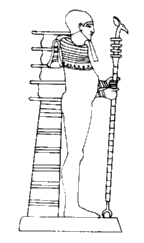
From this myth Ptah is seen to be an intellectual principle of creation amalgamated with the physical image of Ta-tenen as the primeval mound. It is a complete synthesis of mind and the material world. Known as the 'logos doctrine', there is resounding echo of this impressive philosophical approach to the cosmos formulated by the priests of Memphis in the... New Testament." George Hart, Egyptian MythsPtah was the major god of Memphis, married to the fierce Sekhmet, the goddess of anger and vengeance (Imhotep, the grand architect, was often regarded as their son). He is the god of creation, masonry and crafts. He is depicted as a bearded man wearing a skullcap, often seated bandaged as a mummy holding the Uas (phoenix- headed) sceptre, an ankh, and a Djed (sign of stability). In the Memphite cosmology, Ptah was seen as the creator of the universe. According to some myths, Thoth created the specifications and secret words of the universe, which Ptah then fashioned.
Symbols: Architect's transit, level, plumb-line, bricks
Offerings: Items created by hand for artistic or practical purposes
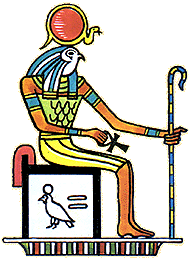
Homage to thee, O thou who hast come as Khepera, Khepera the creator of the gods, Thou art seated on thy throne, thou risest up in the sky, illumining thy mother [Nut], thou art seated on thy throne as the king of the gods. Book of the DeadRe is the sun god, and his name is thought to mean "creative power" or "creator". He was seen as the father of the other gods, and once held rulership over all of them. In time he retired, but Isis had managed to trick him into revealing his true name to her so the rulership continued in her family.
Ra is commonly depicted as a falcon headed man with a solar disc above his head. He was originally identified with Horus, but in time became an independent deity who overshadowed him. During the new kingdom he was in turn overshadowed by Amun. He is also sometimes called Khephra, the scarab holding the sun.
Symbols: Bennu (phoenix), obelisk, pyramid, Udjat (Eye of Horus), sun, falcon, bull
Offerings: items of great worth or quality, obelisks and pyramids, beef, beer, mummified falcons and bulls
...an invisible creative power which was the source of all life in heaven, and on the earth, and in the great deep, and in the Underworld, and which made itself manifest under the form of Ra. E.A.Wallis Budge, Gods of the EgyptiansThe name means the Hidden One, and he was believed to be the original transcendent creative principle, hidden and eternal. During the New Kingdom he became the new king of the gods, the patron deity of Thebes. He was seen as the creator of all things, of whom the other gods were just manifestations; he assimilated the other solar deities. His consort was Mut "Mother", the egyptian version of the "Great Mother" archetype, mother of the moon-god Khonshu. The triad were worshipped in the great temples of Luxor and Karnak. Some choristers claim Amun was the first clear vision of the One.
He was depicted in many ways, as a bearded man wearing a cap surmounted by two tall plumes, a frog headed-man (when seen as a primordial deity), a cobra-headed man, an ape, a lion or an enthroned man, but the human forms were most common.
Symbols: ram, goose, bull
Offerings: gold, lapis, beef, perfume

Ma'at means righteousness, truth, and justice within a level and ordered symmetrical scheme and cannot be properly translated into English. Knight and Lomas have chosen "Freemasonry" as the closest equivalent meaning. Richard Shand, Masonic Belifs and RitualsMaat is the wife of Thoth, the goddess of physical and moral law, truth, justice, order and balance, depicted as a woman with a ostrich feather in her hair (the feather of truth). She represents the divine order of the universe, the order which can not and should not be broken. The Law of Maat is in some sense the paradigm, and mages or sleepers breaking it must face the consequences. In the past, the laws of the land had to conform to the Law of Maat, or disorder and chaos would result (as in the case of Akhenaten's heresy). It is interesting to compare this to the concept of sharia in Islam, where the laws must conform to the spirit of the acts of Mohammed.
Some hermetics identify her with the gnostic Sophia.
Symbols: ostrich feather, scales
Offerings: ostrich feathers, heart-amulets, clean sand
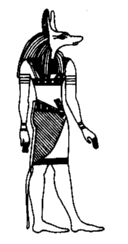
Anpu, who is upon his hill, hath set thee in order, and he hath fastened for thee thy swathings, thy throat is the throat of Anubis and thy face is like that of Anubis. the Book of the Dead, Chapter CLXXIIThe jackal-god of mummification and the quests after death, and possibly co-ruler with Osiris of the underworld (one interpretation is that Anubis rules the underwould outside the Kingdom of Reeds). He protects the dead, both their mummies from decay and their souls from attacks in the underworld.
Anubis is the son of Nephtys and Set or Osiris (according to some stories, Nepthys seduced Osiris which might be an explanation of the enmity between the two gods).
He is usually depicted as a jackal-headed man, holding the divine sceptre.
Symbols: jackal, embalming equipment, flail, flags
Offerings: pottery, embalming equipment, beef, water, sand
Isis, according to Plutarch, represented the part of the world which is visible, while Nephthys represents that which is invisible, and we may even regard Isis as the day and Nephthys as the night. Isis and Nephthys represent respectively the things which are and the things which are yet to come into being, the beginning and the end, birth and death, and life and death Egyptian Antiquity InformationHer name means "Lady of the house", refering to the part of the sky where Horus lived. The sister of Isis, wife of Set. She is a goddess of the memory of the dead, and some mages regard her as the "goddess of that which isn't eternal" (there is a small sect of Euthanatos who regard her as the goddess of the Good Death).
Nephtys appears to be linked to Isis, both as her opposite and at the same time confidant. She helped her with the resurrection of Osiris, and is often mentioned together with her sister.
Symbols: kite, crow, bones and skulls
Offerings: frankincense, items related to one's ancestors, flowers
Symbols: goose, earth
Offerings: black earth, furniture, cool water
Nuit is the goddess of the sky, the great mother of the gods, stars and sun and moon. According to the Heliopoletan myth she gave birth to the World Egg. She is often depicted above her husband Geb, held in a semicircle by her father Shu, or as a woman with a vase of water on her head.
Symbols: stars, the night sky, cows, pigs
Offerings:cool water, milk, flowers
Symbols: ostrich feathers, wind, flags, lion
Offerings: ostrich feathers, precious stones and metals, beef, perfumes
Tefnut is Shu's wife, the goddess of the moisture of the sky. Tefnut was depicted in the form of a woman who wears on her head the solar disk circled by two cobras. She holds in her hands the sceptre and ankh. Many times she has the head of a lioness or is shown as one.
Symbols: throne, rain, lion
Offerings: cool water and sweet liquids
Sirius is the one consecrated to Isis, for it brings the water. Plutarch
From the southern sky, the ancients had chosen thirty-six stars or constellations, the decans, whose consecutive helical risings occurred approximately every ten days. The rising of each decan occurred after it had passed seventy days of invisibility, a period corresponding to that of mummification. Among these stars are Osiris (Orion) and Isis-Sothis (Sirius), symbols of yearly renewal, of the regeneration of the Nile, of cyclic death and rebirth. Lucy Lamie, Egyptian MysteriesThe star Sirius/Sothis played an important role in the cult as timekeeper. The annual swelling of the Nile begins during the hottest time of the year, at the same time as Sirius rises at the same time as the sun (today July 23). This formed the basis of the Egyptian calendar, and the year begun with the rise of Sothis. The calendar had twelve 30-day lunar months plus five extra epagomenal days sacred to the gods Osiris, Horus, Set, Isis and Nephtys. However, the calendar slowly shifted with a period of 1460 years, a period called a sothic cycle.
Sothis was a seen as a manifestation of Isis linked with renewal, growth and timekeeping. Isis was often depicted as a woman bringing water with a star, a symbol still found in the seventeenth arcanum of the tarot, the Star.
During classical times Sirius was described as red in colour, but today it is white. This symbolises the eventual move of the statue of the goddess to upper Egypt (whose colour is white rather than the red of lower Egypt).
Much of the above material (especially the lists of offerings and
symbols) was based on information found on the House of Netjer's official site.